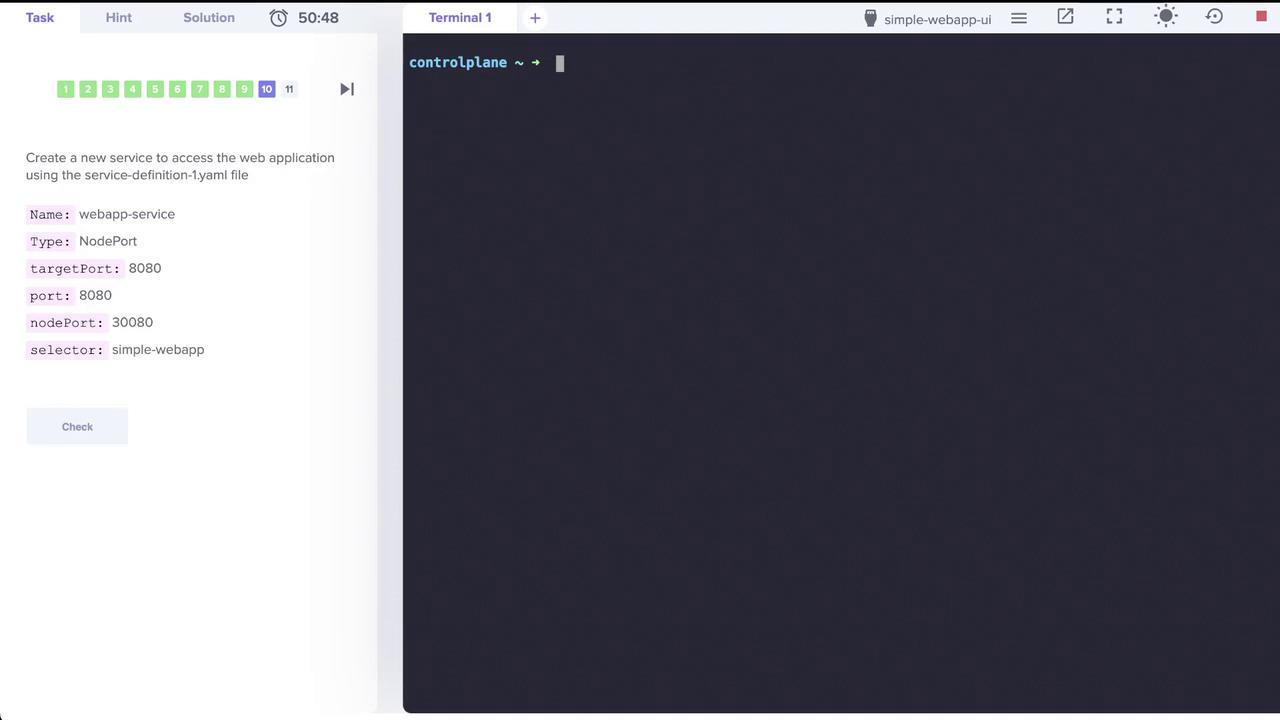Kubernetes for the Absolute Beginners - Hands-on Tutorial
Services
Lab Solution
In this guide, we will walk through the solution for the lab on Services in Kubernetes. The instructions include identifying existing services, checking service types, inspecting target ports, verifying labels and endpoints, reviewing deployments, and finally creating a service to expose a web application.
Identifying Existing Services
The first step is to check how many services are running on your system. Run one of the commands below:
kubectl get service
or use the shorthand:
kubectl get svc
The output should look similar to:
kubectl get service
NAME TYPE CLUSTER-IP EXTERNAL-IP PORT(S) AGE
kubernetes ClusterIP 10.43.0.1 <none> 443/TCP 10m
This output confirms that there is only one service running—the default Kubernetes service.
Checking the Service Type
Next, verify the type of the default service by executing:
kubectl get service
and
kubectl get svc
You should see output like this:
controlplane ~ ➜ kubectl get service
NAME TYPE CLUSTER-IP EXTERNAL-IP PORT(S) AGE
kubernetes ClusterIP 10.43.0.1 <none> 443/TCP 10m
controlplane ~ ➜ kubectl get svc
NAME TYPE CLUSTER-IP EXTERNAL-IP PORT(S) AGE
kubernetes ClusterIP 10.43.0.1 <none> 443/TCP 10m
controlplane ~ ➜
This confirms that the service type is "ClusterIP". We will focus on this configuration for now, with further details to be discussed later. To verify, run:
kubectl get service
NAME TYPE CLUSTER-IP EXTERNAL-IP PORT(S) AGE
kubernetes ClusterIP 10.43.0.1 <none> 443/TCP 10m
kubectl get svc
NAME TYPE CLUSTER-IP EXTERNAL-IP PORT(S) AGE
kubernetes ClusterIP 10.43.0.1 <none> 443/TCP 10m
Inspecting the Target Port
To determine the target port configured on the Kubernetes service, use the following command:
kubectl describe svc kubernetes
You will see output similar to:
Name: kubernetes
Namespace: default
Labels: component=apiserver
provider=kubernetes
Annotations: <none>
Selector: <none>
Type: ClusterIP
IP Family Policy: SingleStack
IP Families: IPv4
IP: 10.43.0.1
IPs: 10.43.0.1
Port: https 443/TCP
TargetPort: 6443/TCP
Endpoints: 10.53.180.9:6443
Session Affinity: None
Events: <none>
Notice that the target port is set to 6443.
Verifying Service Labels
Next, check the labels that are configured on the Kubernetes service. From the output above, you can see two labels:
- component: apiserver
- provider: kubernetes
These labels indicate that the service is associated with the Kubernetes API server. Details about the API server will be covered in a later section.
Exploring Endpoints
Endpoints represent the pods that the service directs traffic to. The output shows one endpoint:
kubectl describe svc kubernetes
...
Endpoints: 10.53.180.9:6443
...
What Are Endpoints?
Endpoints list the pods selected by the service based on specified labels. For example, if a service targets three pods (all matching the label selector), then three endpoints will be listed. Conversely, if an extra pod is unintentionally matched, the endpoints list will increase, which could affect traffic routing.
Endpoints are essential for troubleshooting. If the service's selector does not match any pod labels, the endpoints list will be empty, indicating why the application may not be accessible. In a properly configured scenario, services map pod endpoints by associating the service with the IP addresses of matching pods.
Here are two diagrams provided for visualization:

If additional pods inadvertently match the service selector, the endpoints list will expand, potentially impacting traffic routing:

In our lab scenario, the Kubernetes service has just one endpoint:
controlplane ~ ↳ kubectl get service
NAME TYPE CLUSTER-IP EXTERNAL-IP PORT(S) AGE
kubernetes ClusterIP 10.43.0.1 <none> 443/TCP 10m
controlplane ~ ↳ kubectl get svc
NAME TYPE CLUSTER-IP EXTERNAL-IP PORT(S) AGE
kubernetes ClusterIP 10.43.0.1 <none> 443/TCP 10m
controlplane ~ ↳ kubectl describe svc kubernetes
Name: kubernetes
Namespace: default
Labels: component=apiserver
provider=kubernetes
Annotations: <none>
Selector: <none>
Type: ClusterIP
IP Family Policy: SingleStack
IP Families: IPv4
IP: 10.43.0.1
IPs: 10.43.0.1
Port: https 443/TCP
TargetPort: 6443/TCP
Endpoints: 10.53.180.9:6443
Session Affinity: None
Events: <none>
Reviewing Deployments
Now, let’s check the number of Deployments in the default namespace by running:
kubectl get deploy
The output indicates there is one deployment present.
Inspecting the Deployment
Inspect the deployment responsible for creating the pods:
kubectl describe deploy simple-webapp-deployment
The detailed output shows the deployment specifics, including the container image:
Name: simple-webapp-deployment
Namespace: default
CreationTimestamp: Fri, 15 Apr 2022 20:35:47 +0000
Labels: <none>
Annotations: deployment.kubernetes.io/revision: 1
Selector: name=simple-webapp
Replicas: 4 desired | 4 updated | 4 total | 4 available | 0 unavailable
StrategyType: RollingUpdate
MinReadySeconds: 0
RollingUpdateStrategy: 25% max unavailable, 25% max surge
Pod Template:
Labels: name=simple-webapp
Containers:
simple-webapp:
Image: kodekloud/simple-webapp:red
Port: 8080/TCP
Host Port: 0/TCP
Environment: <none>
Mounts: <none>
Volumes: <none>
Conditions:
Type Status Reason
Available True MinimumReplicasAvailable
Progressing True NewReplicaSetAvailable
OldReplicaSets: <none>
NewReplicaSet: simple-webapp-deployment-7b59598d59 (4/4 replicas created)
Events:
Type Reason Age From Message
---- ------ ---- ---- -------
Normal ScalingReplicaSet 63s deployment-controller Scaled up replica set simple-webapp-deployment-7b59598d59 to 4
The container image used to create the pods is:
kodekloud/simple-webapp:red
Accessing the Web Application UI
At this point, you may try to access the web application UI using the link provided in the deployment tab; however, you will encounter a "bad gateway" error. This occurs because there is no service configured to expose the deployment:
controlplane ~ ✗ kubectl get deploy
NAME READY UP-TO-DATE AVAILABLE AGE
simple-webapp-deployment 0/4 0 0 15s
controlplane ~ ✗ kubectl describe deploy simple-webapp-deployment
Name: simple-webapp-deployment
Namespace: default
CreationTimestamp: Fri, 15 Apr 2022 20:35:47 +0000
Labels: <none>
Annotations: deployment.kubernetes.io/revision: 1
Replicas: 4 desired | 4 updated | 4 total | 4 available | 0 unavailable
StrategyType: RollingUpdate
MinReadySeconds: 0
RollingUpdateStrategy: 25% max unavailable, 25% max surge
Pod Template:
Labels: name=simple-webapp
Containers:
simple-webapp:
Image: kodekloud/simple-webapp:red
Port: 8080/TCP
Host Port: 0/TCP
Environment: <none>
Mounts: <none>
Volumes: <none>
Conditions:
Type Status Reason
Available True MinimumReplicasAvailable
Progressing True NewReplicaSetAvailable
OldReplicaSet: <none>
NewReplicaSet: simple-webapp-deployment-7b59598d59 (4/4 replicas created)
Events:
Type Reason Age From Message
Normal ScalingReplicaSet 63s deployment-controller Scaled up replica set simple-webapp-deployment-7b59598d59 to 4
Warning
Since no service is exposing the deployment, the web application is not accessible.
To resolve this, create a new service using a YAML configuration file.
Creating a Service to Expose the Web Application
Below is an example YAML configuration file that defines a Kubernetes service to expose the web application:

The service YAML template is as follows:
apiVersion: v1
kind: Service
metadata:
name:
spec:
type:
ports:
- targetPort:
port:
nodePort:
selector:
name:
A more complete example from the Kubernetes documentation is:
apiVersion: v1
kind: Service
metadata:
name: my-service
spec:
selector:
app: MyApp
ports:
- protocol: TCP
port: 80
targetPort: 9376
For our web application, we will create a service with the following specifications:
- Name: webapp-service
- Type: NodePort
- Target port: 8080 (the port on which the application is running)
- Port: 8080 (the port to expose)
- NodePort: 30080
- Selector: name set to simple-webapp
Here is the complete YAML configuration:
apiVersion: v1
kind: Service
metadata:
name: webapp-service
spec:
type: NodePort
ports:
- targetPort: 8080
port: 8080
nodePort: 30080
selector:
name: simple-webapp
Apply the configuration with the following command:
kubectl create -f service-definition-1.yaml
The command should output:
service/webapp-service created
After creating the service, verify that it is working by accessing the web application UI.
Additional Ways to Create Services
In future sections, we will explore how to use imperative commands to create services. Here are some examples:
kubectl expose pod redis --port=6379 --name redis-service --dry-run=client -o yaml
kubectl create service clusterip redis --tcp=6379:6379 --dry-run=client -o yaml
kubectl expose pod nginx --type=NodePort --port=80 --name=nginx-service --dry-run=client -o yaml
This concludes the lab walkthrough. By following these steps, you have learned how to manage services and deployments in Kubernetes effectively.
Watch Video
Watch video content